 Ever been to Hurricane Ridge in Olympic National Park? Perched on the northernmost edge of the Olympic Mountains above Port Angeles, it's easy to get to and offers stunning views.
Ever been to Hurricane Ridge in Olympic National Park? Perched on the northernmost edge of the Olympic Mountains above Port Angeles, it's easy to get to and offers stunning views. But just a few miles eastward with even more spectacular, 360 views (and almost as easy to access) is much-less visited Deer Park.
A couple weeks ago I was fortunate to join Olympic National Park field scientist Bill Baccus on a morning trip up to Deer Park/Blue Mountain in the very northeastern corner of the park. Lucky me, the weather was sunny and mild, in fact just about perfect really.
Be forewarned that the drive up to Deer Park is a little harrowing if you're at all squeamish about heights. As driver Bill cheerfully told me about his work on the way up the one-lane, narrow dirt road with no guardrails and very steep drop-offs, I inwardly squelched my anxiety and looked straight ahead. Not down.
As a guest blogger for the Washington's National Park Fund, which is helping to fund the glacier monitoring program Bill leads, my goal was to learn about the program so far and report on it. The news isn't so great. (Read about it here.)
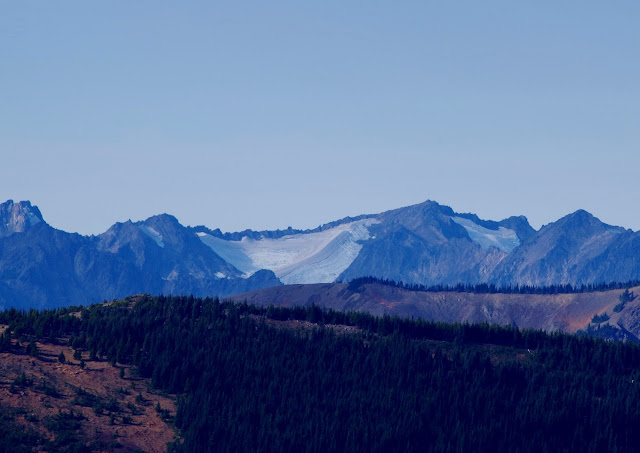 |
| Carrie Glacier as seen from Blue Mountain. |
While Bill was off repairing a remote climate monitoring station near the Deer Park campground, I walked the Rain Shadow Loop trail at the summit of Blue Mountain, about a quarter-mile above.
 |
| View west of Klahhane Ridge and Mt. Angeles, road to Hurricane Ridge is the hillside cut. |
This short half-mile loop around the summit doesn't disappoint on a clear day.
Okay, that's an understatement. Views up there are fling your arms wide, twirl around, and sing like Julie Andrews or shout in euphoria for the panoramic beauty of it all. (Which I didn't do because I was too busy taking a billion pictures...but I thought about it.)
You can see north into Canada (Vancouver Island and B.C mainland), east to Cascade volcanoes such as Mt. Baker and elusive Glacier Peak, south deep into the craggy Olympic Mountains, and west up the Strait of Juan de Fuca.
 |
| South, (think) Obstruction Peak |
 |
| Southeast |
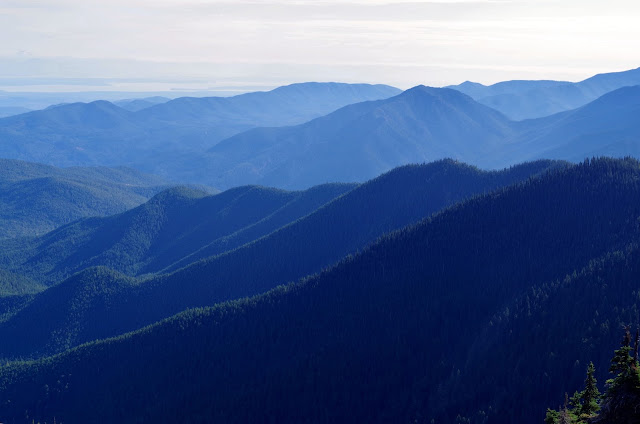 |
| Eastward, Puget Sound visible in upper left. |
 |
| Northeast, Mt. Baker (Kulshan) in the distance. |
 |
| Tanker headed east on the Strait of Juan de Fuca. |
Some of the lichen, plants, and trees up here don't generally grow west of the Cascade Crest, such as lodgepole pine (which, like glaciers, are threatened by climate change).
Yes, there are a few longer and more rigorous hiking trails that head into the park wilderness from here. But this is what I had time for, and it thrilled me just the same.
Happy trails and thanks for visiting Pacific Northwest Seasons! And I'd love to hear in the comments below about your Northwest experiences.
In between blog posts, visit Pacific NW Seasons on FaceBook, Twitter, and Instagram for more Northwest photos and outdoors news.
When You Go
We're getting close to the end of the season to access Deer Park and Blue Mountain summit, but as of today the Deer Park campground was still open. From Highway 101 that runs along the northern peninsula, take the Deer Park exit just east of Port Angeles and head on up. When you reach the dirt road, you're within the national park boundary. It's 18 miles from Hwy 101 to the trailhead. Big rigs and trailers aren't recommended on the narrow gravel road to the top.










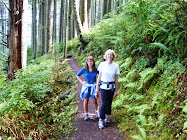

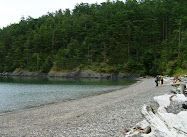
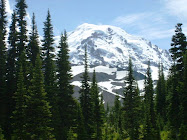



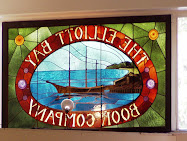

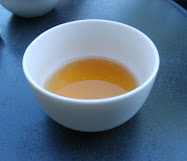
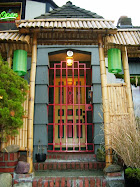


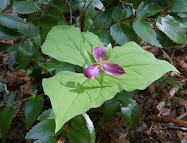

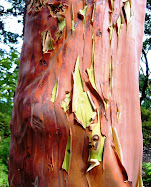

6 comments:
What gorgeous views although your description of the road sounds very scary to me. I've been to Hurricane Ridge though, that was awesome.
Great reporting! It's alarming to see the numbers on how quickly glaciers are receding, and this year's drought sure didn't help. I didn't realize that the Olympic NP glaciers are melting more rapidly than those elsewhere in our state.
Your photos of the views from Deer Park are beautiful! I haven't been to Olympic NP in a long time, but I remember visiting Hurricane Ridge and looking out at those snow- and glacier-capped peaks. Let's hope the park is capitalizing on those amazing views and captive audience to educate visitors on glacier loss and climate change!
Hey JoJo, thanks. Road was scary but not that scary. Easier going down.
Lainey, Thanks for the feedback and clicking through to the other link. Yes,let's hope we can make some progress and slow down our polluting lifestyles. I know I drive probably more than necessary, although trying to bike more. But with the colder, darker, wetter days, more of a challenge.
Thank you for the memories your words and beautiful photos of Deer Park prompted of times past camping and hiking in that area with your brother! I remember that "road" well.
While I am certainly not a climate change denier it is worth looking at the long history of the settlement of Iceland and the leap into Greenland and North America. In all these areas, particularly Greenland and northern Canada, the forays were the result of a pattern of warmer weather and ice retreat. Their settlement retreat was the result of the change toward much colder weather and, in the case of North America, smart Indians who ran them out. My own pattern of climate shifts relates to the family homesteading in eastern Oregon, above Harney lake and very close to the bird reserve. We still own 80 acres of the original homestead about the amount required in these drier years to pasture, maybe, a couple of cow in a good year. Family homesteaded in a wet cycle and migrated to California when it dried up. So many things to think about in a complex problem. Very happy to have farm land in the Willamette valley with amply water sat on hard by the water control board - lessons learned from California. Missed you at walnut harvest this year my dear. Mary Lou
Suezy, thanks for the comment. Always enjoy hearing your experiences. Did the Ozette Triangle over a very wet New Year's weekend one year. No one else was out there; bet that would not happen today.
Judy,
Ah, glad I prompted some nice memories for you. Remember you guys backpacking in the Olympics but didn't know you went in or out via Deer Park. This was my first time there!
Mary Lou,
yea have definitely been decadal oscillations in climate over the last 150+ years of some records. But the people who study this tell me that the warming recently is unprecedented and largely anthropogenic. http://www.iop.org/news/13/may/page_60200.html I missed the harvest, next year!
Post a Comment